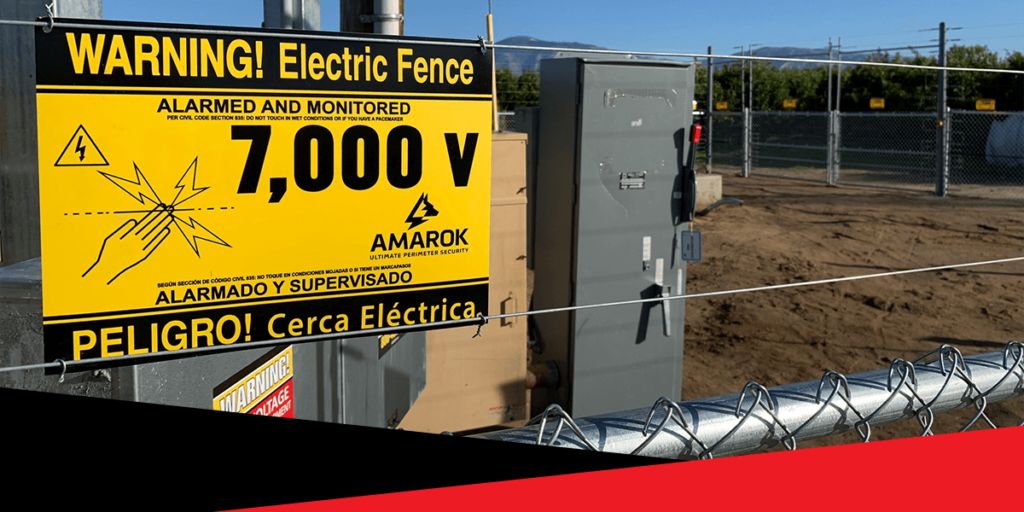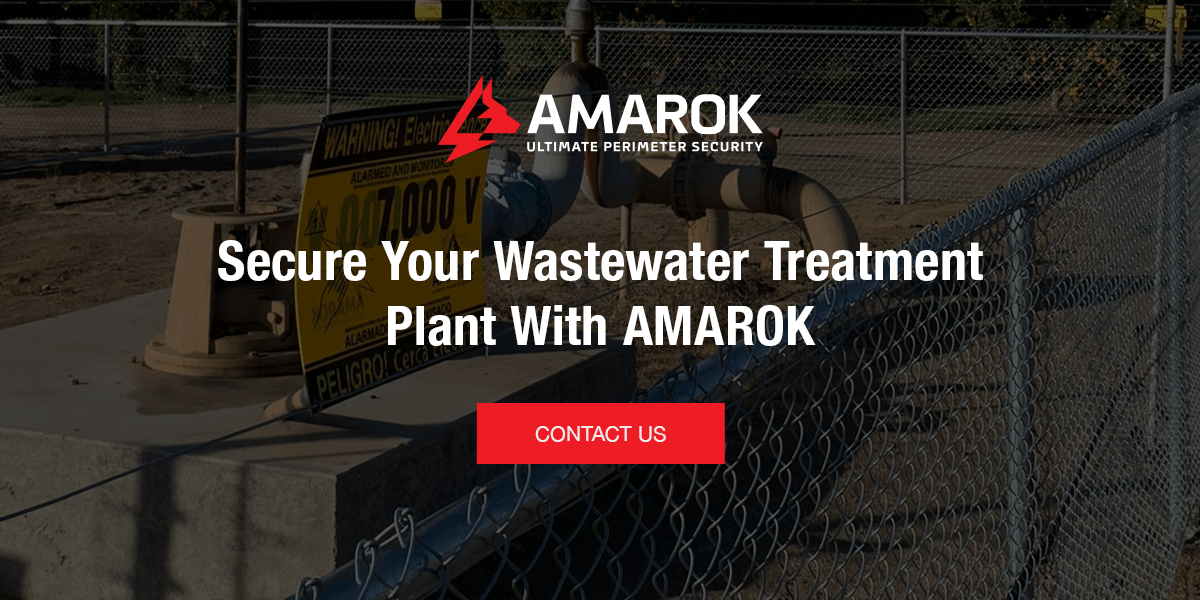Wastewater treatment plants are integral to infrastructure, which is one of the many reasons that criminals target them. Theft, vandalism, and sabotage of these plants are part of a more significant trend of property crimes nationwide. In 2023, there were 179,63 property crimes reported per 100,000 people. These numbers are cause for concern for utilities and commercial businesses alike.
Perimeter breaches to these plants can have catastrophic consequences, including threats to public health. As criminals become increasingly creative, water treatment plant security is at the top of many minds.
Why Wastewater Treatment Plants Are Vulnerable
Water scarcity has become a severe issue amid industrialization and rapid population growth. Wastewater treatment plants provide a solution. These facilities remove harmful pollutants from water before they can be released into the environment, helping protect human health. This process also preserves ecosystems that depend on clean water.
Over 148,000 public water systems exist in the United States. These wastewater treatment systems are vulnerable to various threats, including physical attacks and water contamination. An incident could result in service disruptions and widespread water contamination, impacting public health. The ability to manage wastewater is considered a critical function at a national level, as disruption to the system has the potential to debilitate economic stability and national security.
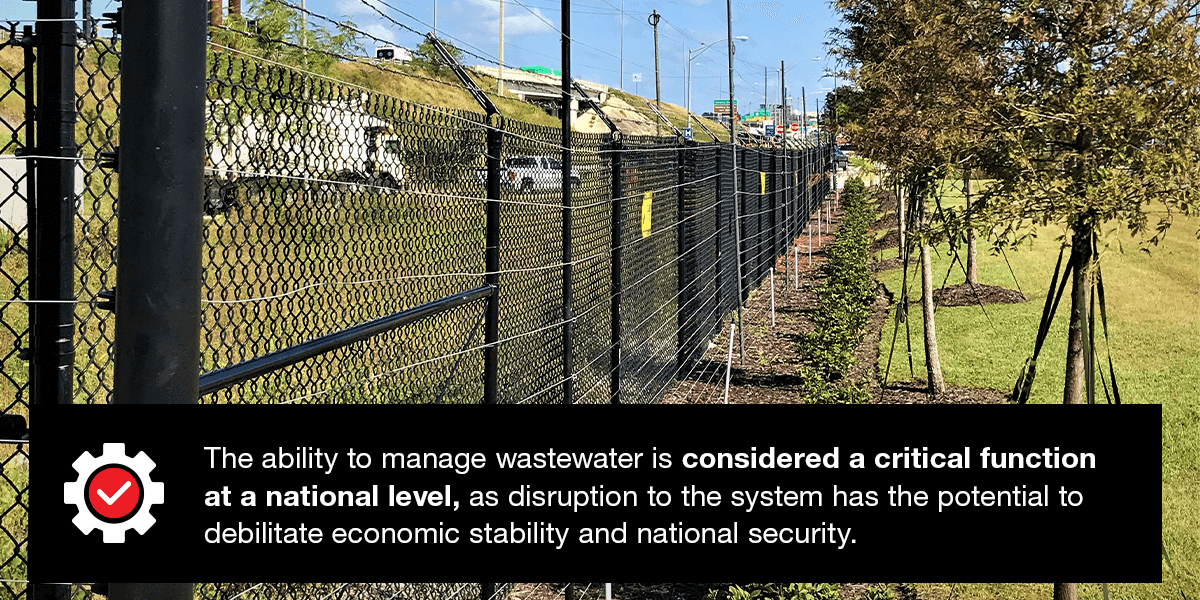
Some of the many reasons water treatment plants are vulnerable to physical security threats include:
Remote Locations and Expansive Perimeters
Even a single wastewater treatment plant requires many acres of space to operate. For example, the Stickney Water Reclamation Plant in Cicero, Illinois, encompasses 413 acres. Monitoring a perimeter of that size can be challenging, and breaches can have significant consequences. Bigger properties make more accessible targets, as would-be thieves have more opportunities to enter undetected.
Because these facilities need so much space to operate, they are often in remote locations, making the surroundings even more challenging to monitor. Large remote properties are also more challenging to secure, which is one reason many utilities need to work on protecting their perimeters.
The Presence of Copper and Other Metals
Many wastewater plants contain valuable metals used in their electrical systems. Metal theft of all kinds is rising due to high commodity prices. Copper is about 30% more expensive than it was five years ago, and criminals can make significant returns selling it on the resell market. In addition to the expense of replacing stolen copper, the theft has far-reaching effects on your overall infrastructure. The disruption that metal theft causes is disproportional to the value of the metal itself.
Disruption or Sabotage
Some intruders have goals other than theft. In some cases, a desire to disrupt services or cause chaos motivates criminals to breach water treatment plants. Tampering with your electrical systems could lead to operational failure, appealing to people looking to make a statement or cause harm. While many criminals wanting to cause these disruptions are turning to cybercrime, physical threats remain a concern.
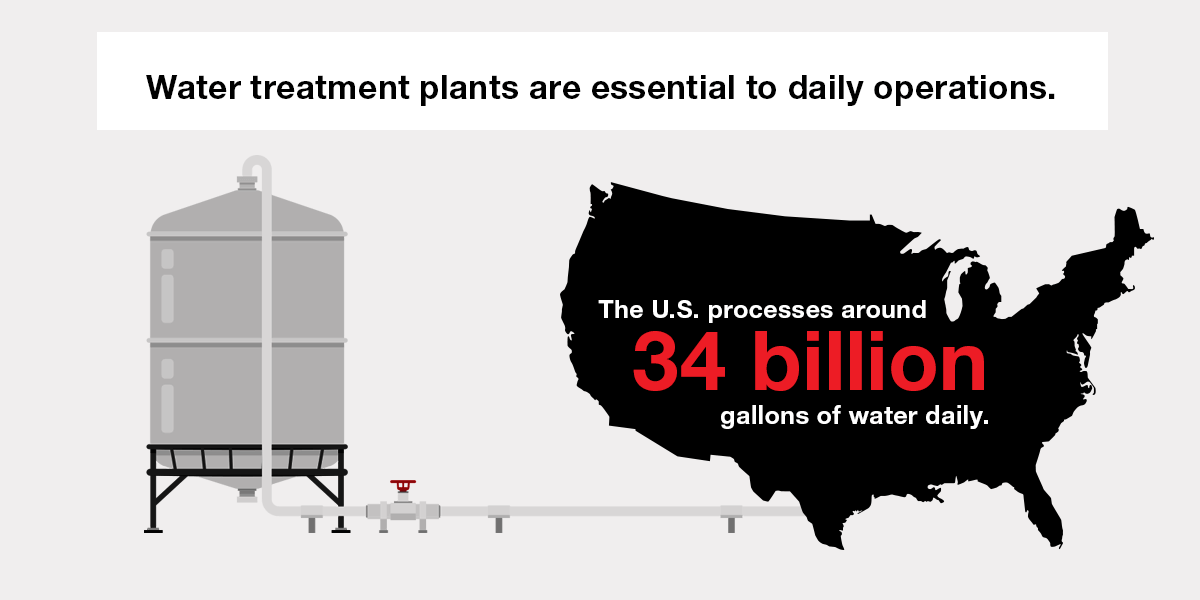
Common Threats to Water Treatment Plants
Water treatment plants are essential to daily operations. In the U.S., they process around 34 billion gallons of water daily. Many of these facilities are unmanned for long periods. In conjunction with their locations in remote areas, their operations open them up to significant threats, including:
Physical Security Breaches
Physical security is non-negotiable in wastewater treatment for several reasons. Due to their remote locations, periods of inactivity, and extensive perimeters, wastewater treatment facilities are easy targets for criminals. Thieves may enter the premises to steal valuable electrical equipment, metals, and water.
Critical infrastructure is also threatened by terrorist activity. Vandals could attempt to disrupt your treatment facility’s operations by denying the community access to clean water. They may even try to poison the water before it’s released into the environment. Criminal intrusions are also a safety risk to your employees.
Any physical breach can have devastating consequences for your plant and the surrounding community. Your plant will suffer significant financial and reputational damage, especially if the attack results in extended downtime and disrupts the population’s access to water.
Cyberattacks
Wastewater utilities face a wide range of cyberattack threats that can disrupt their operations and deny account holders access. Due to their critical role in public health and infrastructure, these plants are prime cyberattack targets.
Cybercriminals often use ransomware, which encrypts valuable wastewater treatment files or denies you access. They then demand money in exchange for the encryption key. Malware is another significant threat. Here, malicious software is used in an attempt to infiltrate your system to disrupt function or steal and exploit sensitive information. The consequences of these attacks are severe and can include massive financial and reputational impacts.
Insider Threats
In addition to external threats, you must account for internal risks as well. Insider threats happen when employees or contractors misuse their access to systems. This misuse can be malicious or accidental. Disgruntled employees or motivated visitors may intentionally damage your system, steal, or leak sensitive information. They also work with external parties, granting them access so they can commit crimes.
Lack of staff training or adherence to security protocols is another considerable risk. Your employees could make mistakes that compromise security, paving the way for criminals to gain access to your systems.
How to Protect Wastewater Plant Operations
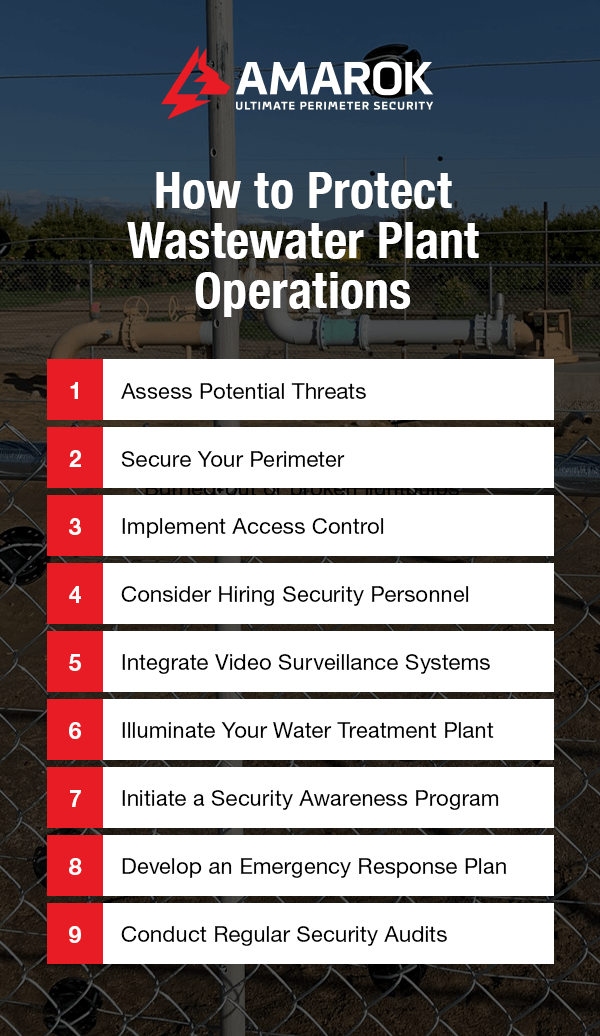
Wastewater treatment plant security is more important than ever in today’s threat landscape. Physical protection of water utilities and wastewater plants requires a layered security approach, as attacking threats from different angles is essential to provide sufficient security coverage for this critical infrastructure.
If you operate a wastewater treatment plant, take the following proactive steps to mitigate security risks:
1. Assess Potential Threats
You can only protect your wastewater plant when you understand its weak points. Relying on security professionals to conduct a threat assessment on your plant highlights vulnerabilities so you can take the appropriate action. A threat assessment assesses internal risks, like employee theft, your infrastructure, and weak points in your operations. It also looks at crime data in your area to identify external risks like theft, vandalism, and any other physical dangers.
The security team will assess any weak points in your training and provide you with a comprehensive, proactive security plan to prevent unauthorized access and minimize costly interruptions.
2. Secure Your Perimeter
Chain link fences are rarely enough to deter ambitious intruders. As threat levels rise, many water treatment plants boost their perimeter security with electric fences. A well-planned security strategy for water treatment plants begins with perimeter fencing that meets your property’s needs.
An electric security fence is an intimidating physical barrier designed to detect and deter criminal activity. For many, it’s the first proactive step in a layered security approach because it discourages criminals from even attempting entry.
A criminal or saboteur looking to make a statement prefers an easy target. An electric perimeter fence gives the opposite impression, and many intruders will think twice before attempting access. A professionally installed electric fence is medically safe and legal, but highly memorable. When criminals touch it, they receive a 7,000-volt pulsed electric shock, enough to deter them from further attempts.
One of the principal challenges in water treatment plant security is the length of the perimeter, as it’s so large that it’s challenging to monitor effectively. Adding enhancements to your electric fence helps you cover remote areas along your perimeter. These may include detection sensors at critical points to alert you if anyone enters the area. Once the system picks up unauthorized activity, it responds by activating a lighting system to illuminate the area. You’ll know exactly where the intruders are so you can alert the authorities.
3. Implement Access Control
Once you have a secure perimeter, you can focus on access control. These measures are essential for monitoring entry and exit and keeping unauthorized visitors out. With physical and cybersecurity threats rising, controlling access points allows you to manage and record movements throughout your plant.
Access control is part of a strong layered security approach, and you can use a combination of several options, including:
- Physical barriers: A physical barrier serves several purposes, including acting as a deterrent and allowing you to control entry and exit. You can also use a physical barrier inside your plant to restrict access to sensitive areas.
- Role-based access control (RBAC): This technology allows you to control access to areas within your wastewater plant based on an individual’s role. This compartmentalization protects sensitive equipment and information from contractors, visitors, or lower-level employees.
- Electronic access systems: These systems make it impossible for unauthorized people to enter while streamlining entry for trusted workers. They rely on resources like key cards and scanners, which are easily updated to reflect employment or role changes.
4. Consider Hiring Security Personnel
Professional security guards can be a valuable enhancement to your security, especially when your wastewater treatment plant is unmanned. Their presence on-site can deter criminals. They can also identify and deal with suspicious activities and act in real time if an incident occurs.
5. Integrate Video Surveillance Systems
You can improve your perimeter security with various enhancements like video surveillance. Firstly, video surveillance cameras are a psychological deterrent — criminals and saboteurs are less likely to cross your barrier if they know there will be footage to help police catch them. These cameras increase the chance that law enforcement can identify and apprehend criminals and recover stolen property if a theft occurs.
You can also use closed-circuit television (CCTV) throughout your plant to increase security and allow security personnel to monitor critical areas like entrances, hatches, and other protected areas. Recordings from CCTV systems can help law enforcement identify criminals and serve as evidence in the event of a crime.
6. Illuminate Your Water Treatment Plant
Criminals want to act under cover of darkness, which is easy at many plants due to their sheer size. They’ll seek out poorly lit areas along your perimeter and inside the property to cover their tracks. Illuminating your perimeter, access points, parking lots, and the dark regions outside your treatment plant eliminate their hiding places.
These lights also make video surveillance more effective inside and outside your plant while promoting greater safety and security, especially when combined with strategies like access control and CCTV.
7. Initiate a Security Awareness Program
You need a culture of security to address theft and vandalism of critical infrastructure. A security awareness program can get your teams on the same page. Provide them with regular security training on operating your various security systems. Encourage awareness throughout your plant and add security checks to all workflows.
Your security training and awareness program should highlight the importance of on-site security. It must provide clear processes for reporting unusual activities within your plant and surrounding areas.
8. Develop an Emergency Response Plan
An emergency response plan is crucial for handling any interruptions to critical infrastructure. It should outline the procedures for various scenarios, including security breaches. Conduct regular drills and training sessions so all your team members understand their roles and responsibilities during an emergency.
Ensure you have a detailed, up-to-date site map highlighting critical areas and evacuation routes. Include mechanisms to review and update your plan based on each incident, regulatory change, and facility modification. Your plan should also address your relationship with local emergency responders and outline procedures for communicating with them.
9. Conduct Regular Security Audits
Criminals are constantly honing and changing their methods. Without frequent security audits, your plant is open to new forms of crime. These audits involve a comprehensive evaluation of your security measures to identify vulnerabilities so you can take proactive steps toward continuous improvement.
You can conduct these audits in-house or bring in third-party security professionals. Use the findings to update your security policies and procedures as necessary.
Secure Your Wastewater Treatment Plant With AMAROK
Everyone operating a wastewater treatment plant must be aware of evolving threats and take steps to stop would-be criminals. Without proactive security, your plant and the community will fall prey to service interruptions and threats to public safety. An integrated security approach and a robust perimeter fence are the best methods to protect your assets and community from crime.
AMAROK’s award-winning, industry-leading solutions are the smarter approach to perimeter security. With over 8,000 happy customers and a 99% customer satisfaction rating, The Electric Guard Dog™ Fence is your first line of defense against criminals. We can implement this perimeter solution alongside other security enhancements like FORTIFEYE™, the nation’s first fully integrated perimeter solution.
The AMAROK security-as-a-service model means that you’ll benefit from our premium security solutions with no upfront costs — just a manageable monthly service fee. Start your perimeter security upgrade with a professional threat assessment, or call us at (803) 786-6333 for more information today!
